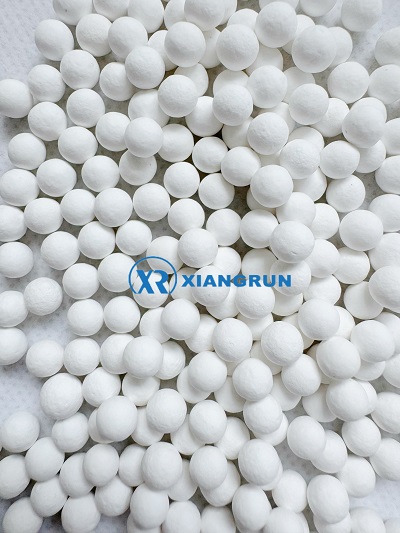The core task of air separation equipment is to separate high-purity oxygen, nitrogen, and argon from the air. However, untreated raw air contains harmful impurities such as moisture, carbon dioxide, and acetylene, which can cause equipment blockage and malfunction, or even serious safety accidents. Therefore, before entering the core cold box, the air must pass through a robust and reliable purification barrier of activated alumina and molecular sieves.
Characteristics:
1. Activated Alumina:
Core Function: Deep drying, primarily targeting moisture.
Working Principle: Activated alumina is a porous, highly dispersed solid material with a huge specific surface area. It has extremely high affinity for water molecules and a high static adsorption capacity. In environments with high relative humidity, it efficiently adsorbs and locks in large amounts of water molecules.
Physical Properties: High mechanical strength and good wear resistance, making it ideal as the bottom support of adsorption beds, withstanding airflow impact.
2. Molecular Sieve:
Core Function: Fine adsorption, removing CO₂ and hydrocarbons.
Working Principle: Molecular sieves are aluminosilicates with a uniform microporous structure. Their "sieving" effect comes from their precise pore size, selectively adsorbing molecules with diameters smaller than their pore size. In air separation, it is mainly responsible for adsorbing carbon dioxide (CO₂) and hydrocarbons (such as acetylene C₂H₂), while simultaneously performing deep drying.
Physical Properties: High adsorption capacity, but relatively low mechanical strength, making it more prone to wear.
Synergistic Effect:
In modern air separation and purification systems, activated alumina and molecular sieves are typically packed within the same adsorber, forming a bilayer composite adsorption bed.
Activated Alumina: Hot, moist compressed air first enters the adsorber, passing through the upper activated alumina bed. At this stage, the vast majority of the moisture in the air (approximately 90%-95%) is efficiently adsorbed by the activated alumina:
· It bears the majority of the water load, protecting the subsequent molecular sieve.
· The large amount of heat released during water absorption creates a more favorable, slightly warmer working environment for the molecular sieve as it enters the lower layer, enhancing its CO₂ adsorption capacity.
Molecular Sieve: The air, pre-dried by the activated alumina, then enters the lower molecular sieve bed. At this point, the air is relatively dry:
It thoroughly removes residual trace moisture, lowering the air dew point to below -70°C.
It efficiently adsorbs carbon dioxide, preventing it from forming dry ice and causing blockage at low temperatures.
It safely adsorbs hydrocarbons such as acetylene, eliminating the risk of explosion and ensuring the safety of the equipment.
The core advantages of this division of labor are:
Protecting the molecular sieve and extending its lifespan:Moisture is a major obstacle for molecular sieves, reducing their adsorption capacity for CO₂ and hydrocarbons and potentially causing them to pulverize. By allowing activated alumina to handle the primary water absorption, the lifespan of the expensive molecular sieve is significantly extended.
Improving overall purification efficiency:By leveraging the strengths of both materials and mitigating their weaknesses, the purification depth and reliability of the entire system reach a level unattainable by any single material.
Optimizing economics:Activated alumina is typically less expensive than molecular sieves. This combination reduces overall operating costs while maintaining performance.
If you have any questions or needs regarding activated alumina and molecular sieves, please contact Zibo Xiangrun Environmental Engineering Co., Ltd. – a professional alumina manufacturer.













